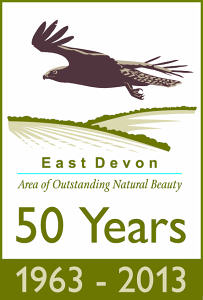Countryside

Musbury has an enviable location. Set in the East Devon Area of Outstanding Natural Beauty (AONB), the surrounding landscape is characterised by intimate wooded combes, vast areas of heathland, fertile river valleys and breathtaking cliffs or hilltops. Not surprisingly, the area is rich in wildlife with local nature reserves providing sanctuaries for birdlife (including, for example, ospreys in the Axe estuary), butterflies, bats, fish and other species.
Arguably the best vantage point for viewing Musbury and its picturesque setting in the Axe Valley is from Musbury Castle the Iron Age fort rising high above the village.
In The Book of the Axe (1875) George Pulman wrote: “The panoramic view of the Valley of the Axe is one of the best throughout its extent, and the eye ranges far beyond that lovely tract – over hill and dale, with water, timber and all other accessories for a perfect English landscape”. Those standing in the same spot today would agree. On a clear day there are views to the South as far as Start Point in South Devon and to the North, you can see beyond Axminster to the Blackdown Hills.
Coast
Musbury is just three miles to the nearest coastline at Seaton and the harbour at Axmouth. The attractive fishing port of Beer is also close-by. They are part of the Jurassic Coast, England’s first natural World Heritage Site. This covers 95 miles of truly stunning coastline from East Devon to Dorset, with rocks recording 185 million years of the Earth’s history.
Biodiversity In Musbury
Musbury is a rich and vibrant area for wildlife. As well as many hedgerows over 1000 years old, Musbury includes two sites of Special Scientific Interest- the River Axe (of particular interest for its geomorphology) and Park Farm Meadows (species-rich unimproved neutral grasslands). Other important sites include Musbury Castle, Musbury Woods, Sellers Wood and Trill Grove Fields.
In late 2009 Musbury was one of seven parishes, all in the Lower Axe Valley, to have a biodiversity audit based on records sent to the Devon Biodiversity Records Centre. The findings are contained in a draft report:
Musbury Parish Biodiversity Audit (draft, Apr 2010)
If you are interested in helping to extend the picture of the wildlife interests in the parish, the report has a number of suggestions for getting involved.
For more information contact the Axe Vale Conservation Society or the East Devon AONB Partnership.
Further Reading
Other free publications of local interest relating to rural matters include:
- Marshwood Vale magazine (this covers West Dorset, South Somerset and East Devon)
- The Landsman, a free magazine about real country living in the south west.
